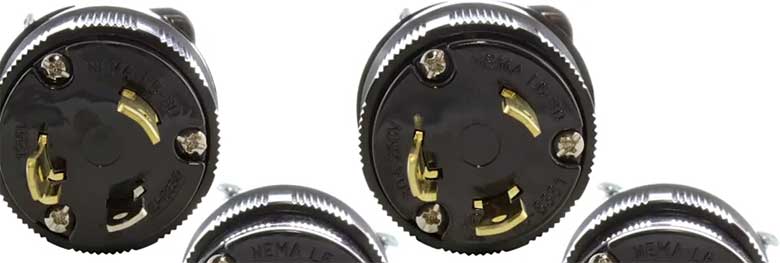The NEMA L6-30P is a three-prong locking male plug with a 30 amp, 250-volt rating. L6-20 is just a 20 Amp, 250 Volt locking female NEMA L6-20. That’s the main difference!
There are nickel-plated pins & terminals in the product to avoid corrosion. You’ll also notice that there’s a built-in power indication light.
This device has a maximum power output of 5000 watts. You’ll get a 5-year warranty coverage with this purchase. Let us check out the difference between L6-20 and L6-30.
A Brief Comparison Table
| Specs | L6-20 | L6-30 |
| Full Name | NEMA L6-20 | NEMA L6-30 |
| Voltage | 240V | 240V |
| Amps | 20A | 30A |
| NEMA Configuration | 6-20P (plug), 6-20R (receptacle) | 6-30P (plug), 6-30R (receptacle) |
| Hot Lines | 2 | 2 |
| Ground Line | Yes | Yes |
| Locking | No | No |
| Typical Uses | Heaters, AC units, pumps | RVs, large appliances, industrial equipment |
Features L6-20 & L6-30 Adapter

- The category of L6-20 and L6-30 is gen purpose wiring devices – gen purpose recept & surge pro.
- Classification of L6-20 is industrial cord connectors whereas residential receptacles is for L6-30.
- L6-20’s features are turn lock receptacle, single 3wire 20amp, and 250v.
- L6-30 features are industrial-grade locking devices are designed for quick and easy installation and provide reliable performance in tough industrial environments.
Advantages of L6-20 Connectors
- Lower Ampacity – The 20 amp L6-20 provides plenty of power for most moderately sized 240V appliances and equipment like air conditioners, well pumps, or electric heaters. The lower amp rating allows smaller gauge wires to be safely used.
- Ubiquity – The NEMA 6-20 is used universally across North America for 240V/20A applications. So you’re more likely to find compatible outlets or extension cords available.
- Cost – Because it utilizes thinner gauge conductors compared to 30 amp configurations, installing wiring for the entire 6-20 circuit is cheaper.
- Safety – There is less chance of electrical hazard or fire since the 20A limit curbs excessive current flow that could overload circuits.
If you only need up to 4800 watts of equipment handling capacity, the affordability and availability of the L6-20 make it an appealing standard for most homeowners and small businesses rather than oversizing things.
Advantages of L6-30 Connectors

- Higher Wattage – L6-30’s extra 10 amps provides 7200 watts to drive larger residential appliances, commercial equipment or power-hungry devices. Things like commercial kitchen gear, big motor-driven pumps, or industrial welder receptacles often utilize NEMA L6-30.
- 30A RV Hookup Compatibility – Most modern recreational vehicles require at least 30 amp, 240V hookups when parked at campsites. The L6-30 allows an RV access to sufficient voltage and power availability to maintain functionality of all its systems and appliances while off the grid.
- Locking Option – For applications requiring vibration resistance or avoiding disconnection – like RVs – some L6-30 plug/outlet combinations come with a locking feature to keep things solidly mated.
- Heavier Gauge Wiring – The 10 gaugeconductors mandated for 30 amp circuits are more robust and designedfor constant high power flow required by larger equipment without overheating or voltage drop.
If running power-hungry equipment or RVs is your need, stepping up to the ruggedness and capability of the NEMA L6-30 is the best route.
Key Disadvantages of Both L6-20 and L6-30
While the L6 series 240 volt plugs have their advantages, there are some downsides to consider with both:
- No Ground Fault Interruption – Unlike kitchen and bathroom 120V outlets, NEMA 6 series receptacles don’t have GFI ability to prevent electric shocks. Adhering to electric code by providing GFI breaker protection at the L6-20 or L6-30 circuit box is vital.
- No Weatherproofing – Neither plug configuration is watertight or corrosion resistant. So you must avoid using them in wet areas like outdoors or in bathrooms unless covered by an extra protective enclosure.
- Ungrounded Versions Problematic – While L6-20R and L6-30R outlets require a ground pin, some older legacy plugs (L6-20P and L6-30P configurations) lack this ground pin which neutralizes shock hazard protection. Always replace ungrounded L6 devices or use a GFI throwing breaker.
- Compatibility Issues – You obviously cannot mate a 20A receptacle with a 30A plug or vice versa. So make sure your outlet amp rating matches the connector on any devices or extension cord.
What Will Be The Suitable Choice For You?
Three-wire grounded NEMA 6-20R (T-Slot) connection rated for 250VAC and 20A NEMA 6-20R (T-Slot). The horizontal and vertical blades of the 6-20P restrict it from being attached to receptacles with lesser amperage ratings. 6-20R (receptacle), on the other hand, has a “T” slot that can connect both a 6-20P (power) and a 6-15P (6-15P).
Large air conditioning systems and commercial ovens are two common examples of this technology. When you need to extend power from a fixed source like an adapter or power drop, you may use our NEMA 6-20 Extensions cable Series.
Smart-UPS T and Symmetra RM 2-6kVA UPS use the NEMA L6-30 as input. For 208 VAC, the NEMA L6-30 outlet is used in the Matrix-UPS, Good T, and single-phase Symmetra devices (Power Array, RM, LX).
The voltage level of 250V and current consumption of 30A make this a two-pole, three grounding connection.
It is a three-prong locking female connector with a 20-amp, 250-volt rating, designated as NEMA L6-20P by the industry. 3-prong, 30-amp female NEMA L6-30R connector with a 250-volt power rating.
The product’s nickel-plated connections and terminals prevent corrosion. A 5-year warranty protects your purchase. You’ll require Adobe® Acrobat® Reader to view PDF files.
Dielectric voltage withstands (Hi-Pot), polarisation, and continuity are verified on each cable. Make an L6-20 female socket, connection, or outlet fit a NEMA L6-30 male connector (30 amp, 250-volt twist lock).
Check whether the item requires more current than the receptacle can provide. Plug a device with a power plug on its charging cable to a locking L6-30R socket or outlets with an L6-30P power adapter.
As you can see, L6-20 and L6-30 both are plugs are good. You can choose according to your needs.
Frequently Asked Questions (FAQ)
The L6-20P on your server will work with the L6-30R (30 amp locking plug) on an L6-30R receptacle. They seem to be of the same kind. The term “converter” was used, but we are unsure what kind of converter you mean. The receptacle in question should accept the plugin question.
It’s safe to say that this guy is an expert. Your IT colleagues will be able to identify you as a professional if you have verified your account. Because the L6-20 is rated at 20 amps whereas the L6-30 is rated at 30 amps, the maximum current the L6-20 can draw via a 30 amp circuit is 20 amps. That’s why everything’s alright, as long as you don’t exceed the rated capacity.
There are locking connectors known as NEMA L6 utilized in circuits up to 250V in voltage. Nominal supply voltages of 240V or 208V, depending on phase arrangement, are designed for two-pole, three-wire L-L-G circuits.
Instead of using a connection, you would use an L5-30R receptacle to insert into an outlet box. L5-30P (pluggable) is the female connector that fits into both.
Finally
When it comes to selecting electrical systems, plugs & plugs seem to be available in a range of layouts. Choosing the incorrect connections for a given application is more accessible when more alternatives are available.
You can ensure that your electrical systems like L6-20 vs. L6-30are adequately defined by collaborating with skilled design professionals.

This was very informative and am super glad to have found your article. My work has a L6-20 plug that I want to plug my tesla into. I found a L6-30P adapter to furthermore plug my cord to that outlet and I wanted to see if it was safe to plug in that L6-30P to the L6-20. Now I know that it will be fine
Thank you!
“The L6-20P on your server will work with the L6-30R (30 amp locking plug) on an L6-30R receptacle. They seem to be of the same kind. ”
This is incorrect. I purchased a L6-20P based on your post, and discovered they are not the same. The are close, but they are definitely different sizes. After additional research, they clearly are not meant to plug into each other. It probably would be wise to be sure of what you are putting out when talking about 20-30 amp circuits.
Manfred is CORRECT!
The L6-30 should be bigger and have the plugs at a greater radius, and the L6-20 should have the plugs closer together. I think it should be very hard to plug one into the other!